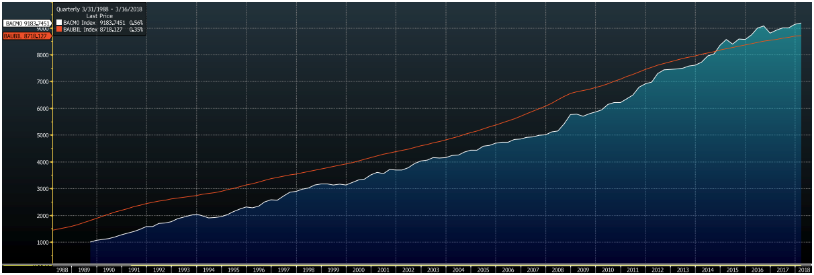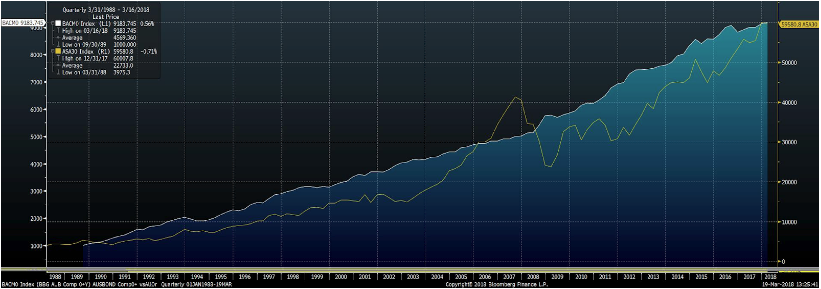Navigating the fixed interest market
Promoted by Cashwerkz.
Sharing Similarities and Understanding Differences – Term Deposits vs Bonds
Australian investors are demanding stable income from their fixed income investments and with standard term deposit rates declining, many investors are hunting for solutions that complement their current mix of income investments that do not place their capital at unnecessary risk.
For investors seeking certainty that their capital will be safely preserved, that mitigates investment risk, whilst delivering a predictable income stream, term deposits have typically been the popular choice. Yet while they form an essential part of every investor’s portfolio, their current low yield make them a little unappealing.
Bonds alternatively provide another popular defensive asset class offering a similar proposition – income from coupons paid at agreed intervals and repayment of face value at maturity. Generally, of bonds available, they tend to be of two distinctive types, either fixed rate or floating rate – each delivering a slightly different yield outcome based on market conditions.
Now let’s compare the two.
Hunting for higher returns
Yield can be defined as the expected return on an investment. For term deposits this is the interest rate, which is fixed for a specified term.
Bonds are issued by companies or governments to raise capital, where investors effectively ‘lend’ money to the issuer and in return the issuer promises to pay a regular interest (a ‘coupon’) payment. Once the bond matures they must return the face value to the investor.
This means the yield can be measured as the interest rate paid to the investor. Yet as bonds can also be traded on a secondary market, i.e. Australian Stock Exchange (ASX) or over the counter via a fixed interest broker (non-ASX), the bond’s capital price can fluctuate providing an investor with the potential for additional yield through capital gains (or capital loss) if sold prior to the bond maturing.
Bonds thus are slightly riskier than term deposits, tending to offer higher interest returns. However, there are much wider variations in yield between government and corporate bonds reflected in the perceived higher risk of a corporate bond investment. As well as gaining potentially higher returns, bonds may provide longer-term income certainty dependant on market conditions and bond type as evidenced by the below comparative chart performance between bonds and Term deposit/bank bill rates from 1988.
Australian Bonds vs Bank Bills Index 1988-2018
Source Bloomberg 19/03/2018
Assurance of Capital
Term deposits are backed by the government guarantee on separate amounts up to $250,000 with any one Approved Deposit-taking Institution (ADI) and as such are the safest investment you can make.
Depending on the bond type, they can be classed either as senior secured or unsecured, or subordinated debt, which places them high up in a bank/ corporate capital structure. Simply this ensures bond investors are prioritised over equity or hybrid investors if the issuing company becomes insolvent.
As a result, there is a strong degree of certainty investors will receive the bond face value back at the maturity date. If a bond issue carries a higher risk of running into financial difficulties, investors should expect a higher “coupon” or “rate of return” as compensation for taking the risk.
When comparing hybrids with bonds, risk and payment ranking need to be taken into account. This is why many investors place hybrids into the equities bucket, as hybrids can convert into equity if APRA believes a bank is underperforming.
Liquidity
Once invested in a term deposit, capital is locked away for a fixed period. If the investor wants to access funds early there’s usually a 31day notice period, may be with a fee payable and loss of interest – however the capital is never placed at risk.
Bonds are generally liquid and, similar to equities, are bought and sold at the market price. When interest rates are low or falling, a fixed coupon bond’s value may increase on the traded market. Conversely, if interest rates are rising, a fixed coupon bond’s value may decrease on the secondary market. Floating rate notes (FRN) which maintain a margin over a benchmark may provide a solution in times of interest rate volatility, as they are generally less volatile in price.
Unlike equities, both bonds and term deposits provide control over the length of the term such that bond maturity dates or deposit terms can release capital at specified times to match cash flows to required investment goals/ liabilities.
Diversification
Investors may view term deposit choices limited to ADI and time horizons available. With bonds, investing is through a wider range of issuers and maturities – from local corporations to international conglomerates – resulting in a greater investment universe than ASX-listed debt securities.
That said, sales of some bonds can be restricted to defined wholesale investors i.e. those who satisfy specific financial or sophistication criteria as certified by an Accountant.
In general, when equities underperform, bonds outperform when markets are unpredictable bonds appear safer and more attractive to investors. In fact, corporate bonds and Australian equities often move in opposite directions. Therefore, investing in bonds may also assist to mitigate risks in holding an equities portfolio as the comparative chart of volatility of investment journey below shows.
Australian Bond vs ASX 1988-2018
Source Bloomberg 19/03/2018
Further, of the two main bond types – fixed rate and floating rate - credit quality varies widely, so prospective bond investors should consider focusing on total portfolio risk through a diversification strategy and investors could potentially achieve higher overall returns with the same overall risk.
However, following the Global Financial Crisis (GFC), ASIC has restricted disclosure of credit ratings to retail investors. Financial advisers may have access to credit ratings, so can provide this added value to their clients with opportunities for investment.
While bonds are issued as either fixed rate or floating-rate notes, some investors may choose to diversify their bond portfolio to include a mix of both. Floating rate coupon bonds in Australia are usually based on the Bank Bill Swap Rate (BBSW). The BBSW can be described as the short term money market benchmark interest rate and is available daily from the ASX (1). It provides referenced interest rates for the pricing and revaluation of derivatives as well floating rate bonds.
Conclusion a strategy alternative
Term deposits and bonds offer a possible solution for investors searching for both capital security and reliability of income. Investors with shorter periods of less than 12 months, term deposits can be a low maintenance, low risk way for a fixed and fair return on investments. And whilst term deposits are available for terms up to 5 years, those with longer time horizons may also consider a selection of bonds as part of a diversified investment portfolio to potentially access higher than deposit yields while at the same time lower volatility than equities.
- https://www.asx.com.au/prices/asx-benchmark-rates










